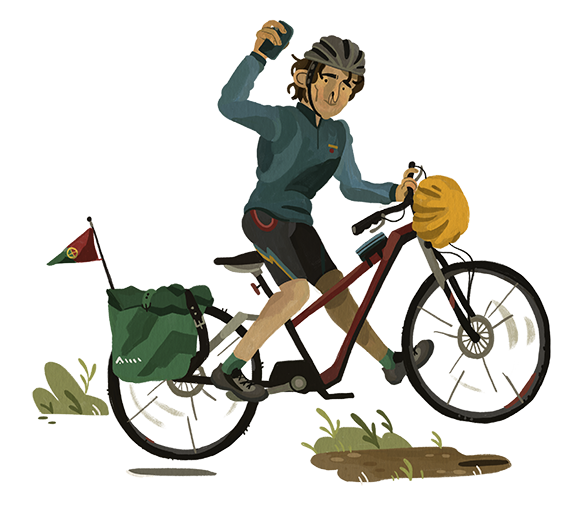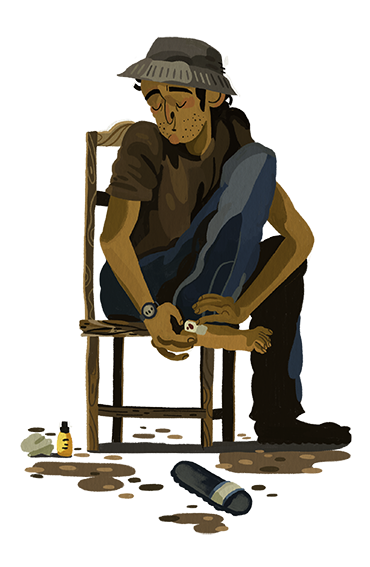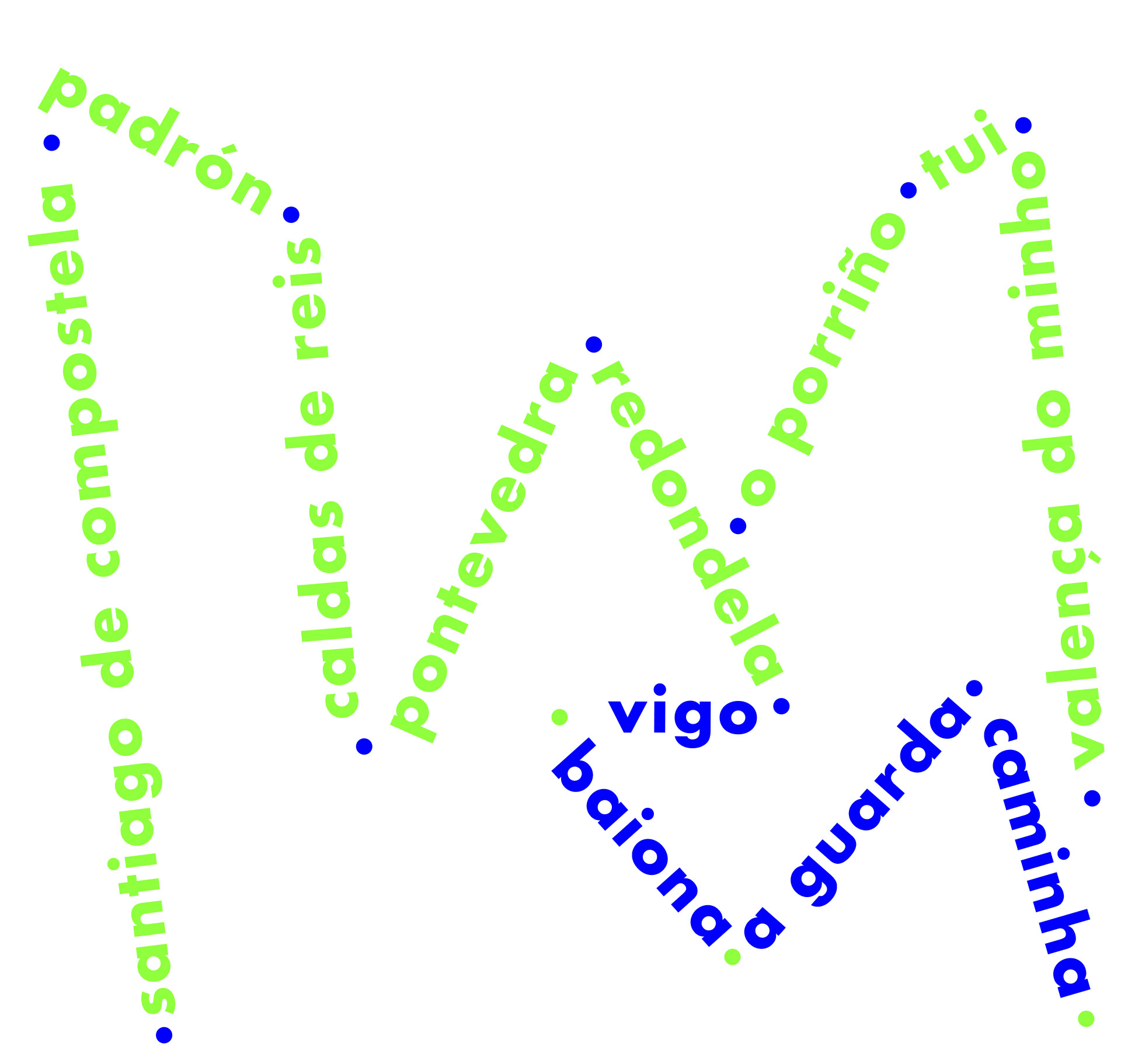the portuguese way (central)
The Central Portuguese Way is one of the greatest long-distance Jacobean itineraries. It was restored in different stages from north to south in 2006. It is 622 km from Lisbon to Compostela, but most pilgrims start their journey in Porto (242 km from Santiago) or at the border of Valença do Minho/Tui (the last 120 km).
The last stages are obviously the most crowded, as this is the most walked route after the French Way. As many as 20.8% of pilgrims chose this way in 2019. More than 33,300 pilgrims start their journey each year in Valença and Tui, making the Eurocidade the third most frequently used starting point after Sarria and Porto.
The last stretch of the way is linked to the story of the Translation. The body of Santiago would miraculously arrive along the Portuguese coast at the Arousa estuary and then head up the Ulla River to Padrón.
Some of the most famous miracles of Santiago are found in Portugal: the miracle of the knight who came out of the sea with his horse covered with scallop shells after looking for the apostolic nave, the miracle of Fernando I in the conquest of Coimbra, and the miracle of the pilgrim accused of theft who is sentenced to be hanged and was freed after the intercession of the saint (galo de Barcelos).
 This way is a great opportunity to illustrate the rich heritage of the spirit: a medieval cathedral, a museum dedicated to all of the arts, sanctuaries, chapels, bridges, Calvary crosses, wayside shrine, etc.
This way is a great opportunity to illustrate the rich heritage of the spirit: a medieval cathedral, a museum dedicated to all of the arts, sanctuaries, chapels, bridges, Calvary crosses, wayside shrine, etc.
Portuguese monarchs such as the Rainha Santa (1325) or Dom Manuel I (1502) completed the route to Compostela. The village was until late the main contingent of pilgrims in the waning days of the 19th century.
With the Marian apparitions of Fátima (1917), however, the Portuguese focused on their national Marian sanctuary. In recent decades, though, the memory of the pilgrimage has been recovered, and the association Amigos del Camino has marked the route in both directions: yellow arrows towards Santiago and blue arrows towards Fátima.
The stretches through Galicia are not particularly difficult because the route largely runs through the so-called Meridian Depression. However, the ups and downs are constant along the Vigo estuary and across the transverse valleys between Pontevedra and Pontecesures.
Except for the final stage between Padrón and Santiago, the Central Portuguese Way runs through the province of Pontevedra – often through densely occupied areas – which reduces the importance of nature.
Regarding the landscape, from the Miño orchard through the valley of A Louriña, there is a significant industrial presence until one reaches the Ría de Vigo. This estuary can be observed from the top, together with the Lérez River, at the beginning of the Ría de Pontevedra. From the provincial capital, the interior regions of Caldas and Sar, filled with important supporting towns, are then entered. We find important heritage resources here, such as the historical sites of Tui, with its cathedral, and Pontevedra, which has deservedly been made pedestrian friendly. The town hall of O Porriño, the viaducts of Redondela, the thermal baths of Caldas and the Jacobean imprint of Padrón and Iria Flavia are other attractions worth visiting for a pilgrim.


Although asphalt and concrete dominate the way, there are still many stretches along agricultural tracks or unpaved roads, including some stony paths. Pilgrims will have not any difficulties in finding services, because hostels and other types of accommodation are very abundant, as are restaurants and shops.
Starting on the way from the Miño River, it takes six days to get to Santiago, including a stop in Pontevedra, or a week if another day is spent visiting the city of Santiago de Compostela.


We recommend that you start your journey at least in Porto, the capital city, which is well connected by plane, train or bus. You will be able to visit the Romanesque church of Rates, the towns of Barcelos, Ponte de Lima and Serra de Labruja. If you do not have time, it would be advisable to start in Valença do Minho, as travelling the Portuguese Way without setting foot in Portugal is completely meaningless.
Half a loaf is better than none. (Saying)
[the saying indicates that you will have to settle for this little bite when there is not enough food]
– You can also go to Valença from Porto, by train from Campanhã station, in about 2 hours, fares from 9 euros (www.cp.pt); by bus with Rede Expressos, from the station Campo 24 de Agosto, in a bit more than 1h 30m, fares from 9 euros; or with Auto Viação do Minho, in about 2 h, fares from 5 euros. You can go direct from the airport Sá Carneiro to Valença with Autna in 1h 20min, fares from 9 euros; via Viana with Andrade Express in 2h, fares from 12 euros; or Alsa, daily, in 1h 25m, fares from 10 euros.
– If you arrive by plane at Peinador airport (VGO), you can go to Vigo by the route 9A bus of Vitrasa, which runs every 30min Monday to Friday, from 5:55 am to 11:07 pm, and on Saturday, from 6:40 am to 11:07 pm, or hourly on Sunday, from 9:30 am to 2:30 pm and every 30 min from 3:00 pm to 11:00 pm, fares from 1.35 euros. This route stops at Travesía de Vigo if you want to travel on foot to the bus station, 1 km away, and at República Argentina, if you want to get to the Vigo Guixar train station, 700m away. Taxis have a fixed price of 22 euros.
– From Vigo to Tui, the best option is going by coach with ATSA, which has frequent service daily (telephone +34 986 610 255), in 35m, 4 euros; weekend service significantly reduced. Travel by Renfe’s train from Vigo Guixar, although service is less frequent, and Tui station is 1 km away from the centre. Two trains going to Porto also pass through the station, stopping in Valença (35m to 55m, fares about 4 euros).
– Tui can also be reached by trains coming from Ourense and Madrid, but at Guillarei station, which is quite far away.
sections
all about tui
WHAT TO DO IN TUI
description
Pilgrim meetings (to get the credentials)
– In the cathedral From 10:45 am–1:00 pm and 4 pm–9 pm, from June to September, to 10 pm in May and to 7 pm the rest of the year. Masses: daily Monday to Friday at 10 am and 1 pm on Sundays and holidays.
The essentials
– Cathedral. The Cathedral looks like a fortress and, in fact, played that role in the Middle Ages. It is accessible through its 13th-century portico, and can be visited as a museum, except during mass (4 euros), including the cloister, from which you can see the Miño.
– Old Town. The Old Town contains one of the most compact and best-preserved monumental complexes in Galicia, made up of the convents of Santo Domingo and Santa Clara, the churches of San Telmo and San Francisco, mansions, the old pilgrims’ hospital. Sections of the wall are still standing.
Our suggestions
– During the summer, you can take advantage of free guided tours organised by the Tourist Office.
– Go to the convent of the Poor Clares and buy some almond peixiños, made with a secret formula for 500 years, which may be of Hebrew origin.
– Don’t miss the Monument to the Wild Horse at the end of the promenade Corredoira, a work full of movement by the Tudense sculptor Juan José Oliveira.
– Have a hot drink with pasta and homemade cakes from the Pilgrim’s Way at Ideas Peregrinas, the premises of the sisters Silvana and Monica, a reference point on the Portuguese Way.
valença do minho – pontevedra


THE VALENÇA–MINHO-PONTEVEDRA STRETCH (54.5 km)
description
After crossing around the Tudense acropolis, we leave the city in front of the Romanesque church of Rebordáns. Shortly afterwards we pass across the beautifully situated bridge Ponte das Febres.
Once in Orbenlle, choose the left branch, also called the Louro River branch, to enter O Porriño through the river park. The heart of the town is in the porticoed Praza Maior, where the neo-medieval Town Hall of Antonio Palacios still stands.


![]()
![]()
![]()
![]()
![]()
![]()
From O Porriño to Mos the situation does not improve until we get to A Rúa, with the church of Santa Baia and the palace of the Marquises. At the end of an ascent we go through Chan das Pipas, with the chapel of Santiaguiño de Antas, to begin the long descent to the Ría de Vigo and Redondela.
![]()
![]()
![]()
![]()
![]()
![]()
In Redondela, you have to pass under two railway viaducts and by the 16th-century public hostel of Casa da Torre, where you can get your credencial [pilgrim’s password] stamped. The next town is Cesantes, from which we see the placid bay of the Isle of San Simón close to the beach.


A steep slope leads to the heights of Lomba and Cabaleira, followed by the quick descent to the town of Arcade, with the arrival at the long Pontesampaio Bridge, which crosses the Verdugo River.
It is amazing that, in such a developed area, the Canicouva roadway may have survived almost intact on the way to Pontevedra. You can follow one road from the chapel of Santa Marta, but there is another worthy and beautiful alternative. The entrance to the city of Pontevedra seems endless, but the old town ultimately makes its appearance and it is the best place to stay if you have the chance.
![]()
![]()
![]()
![]()
![]()
![]()
Our suggestions
– Don’t hesitate to enter the church of San Bartolomeu de Rebordáns, of Suebi or Visigothic origin, if it is open, as it is one of the oldest churches in Galicia and is notable for its 12th-century Romanesque style and capitals.
– The pass over the humble Ponte das Febres reminds us of the Dominican San Telmo, who, despite being from Frómista (Palencia, on the French Way), ended up being the patron saint of Tui and sailors. Here, with symptoms of the plague, in 1246 he knew his end was near.
– If you want to eat peacefully, you can take your own food and stop at the Louro River park before entering the town O Porriño. However, if what you want is animation, just look for a terrace in the Praza Maior and its surroundings.
– Historical strata accumulate around the chapel of Santiaguiño de Antas: up to 60 dolmens (antas) have been located in the area, and the Roman road from the 19th century used to pass by here. Among the modern contributions, there is a memorial to pilgrims and a melancholic nymph statue. Which one would you include in a selfie?
– Consult the timetable for trains passing through Redondela. If you have time on your hands, it is worth seeing the railway pass slowly through overhead the viaduct of Pontevedra, built in 1884, above the houses. Its big brother, or the viaduct of Madrid, has earned a well-deserved rest.
– It is almost a ritual to taste the oysters, in Arcade, whose oyster bed served the palates of kings and courtiers. The oysters are cultivated in pans and, shared between two people, they go in a flash.
– The cannons of Pontesampaio still resound. Situate yourself in the War of Independence: Marshal Ney’s veteran troops on one side and the poorly organised resistance of guerrillas, patriots and students on the other, armed with wooden cannons that burst at the second shot. Well, just as sometimes happens in football, David won, and the gabachos retreated.
all about pontevedra
WHAT TO DO IN PONTEVEDRA
description
Pontevedra is a good town, quenching the thirst of anyone that is wandering through the Ferraría fountain… (popular medieval song)
…but not only with water.
Pontevedra is a fascinating city that deserves at least one full day of our journey, which allows you to get to know the old town, the Pilgrim’s Sanctuary, the entertaining provincial museum, local parks, tapas area, and so forth.
Pilgrim meetings
– Pilgrim Virgin Sanctuary. Built in 1794 by order of the Refuge and the Divine Pilgrim brotherhood, the temple stands on a scallop-shaped floor, and it has a convex façade. This was unbecoming for a neoclassical style, but still shows appreciation for the Baroque. The image, in her dressing room, seems to be dressed for a dance at Versailles at the court of Louis XV. Masses: daily at 7:30 pm (for pilgrims), 1 pm on Sundays and holidays.
The essentials
– Such an incredible old town! Could Santiago overcome it? Perhaps in terms of monuments, but not so much in terms of harmony and neatness. In Pontevedra, everything is impeccable, and you can’t even see any cars. The city has been honoured many times, with awards such as the European Mobility Award (2013) or the UN Habitat (2014). Places like A Ferraría and, above all, A Leña, are sites that you will not forget. It is best to walk in a leisurely fashion, and leave the walled almond groves to prolong our steps along the 19th-century boulevard.
– Church of Santa María. This church belonged to the guild of thugs and now bears the title of minor basilica. Here the final Gothic or Elizabethan style, Manueline dressing and the plateresque style of the main façade converge without stridency.
– The Pontevedra Museum. This is an authentic leader for Galician culture, organised in no less than six buildings from different periods. Its collections are extremely varied: from prehistoric treasures to statues from the Portico da Gloria, and from the best classical paintings to the decorative arts, including Sargadelos ceramics, works by Castelao and other Galician artists and even a reproduction of the cabin of the frigate Numancia.
Our suggestions
– At midday, go to the food market where, in addition to discovering seafood from the estuary of Pontevedra and the Atlantic, you can eat on the upper floor, which has been an interesting gastronomic space since 2019.
– If you like classic cafés, don’t forget to go to the Moderno, decorated with paintings, where the Galician intelligentsia met in the first decades of the 20th century.
– You can also go for a few glasses of wine, beers and tapas in the old town, one of the best places in Galicia to practise this healthy pastime. The number of choices is immense, with close to 300 bars!
– If you stay one more day in the city, cross the river to A Xunqueira and visit the great park of A Illa das Esculturas, where you can find up to 12 great artistic works by the best contemporary creators.
![]()
![]()
![]()
![]()
![]()
![]()
pontevedra – santiago


THE PONTEVEDRA–SANTIAGO DE COMPOSTELA STRETCH (65.2 km)
description



We leave Pontevedra across the Burgo Bridge, which was already in place during Roman times, to continue from the xunqueiras de Alba to the church of Santa María de Alba. In parallel with the railway, we enter a wooded area traverses the vineyards of Barro.
The route is marked with a series of crosses and approaches the paradisiacal enclave of Muíñada de Barosa, formed by a group of mills around waterfalls and pools for bathing.
We reach the thermal village of Caldas de Reis on level ground under the wine arbours. From Caldas de Reis, the forest gains ground accompanying the Bermaña River until Carracedo and then by descending to the Valga River until reaching San Miguel a little further on.
We say goodbye to the province of Pontevedra by skirting the town of Pontecesures and crossing the Ulla River heading to Padrón, the true cradle of the Jacobean tradition.
![]()
![]()
![]()
![]()
![]()
![]()
There are a number of interesting places on the way between Padrón and Santiago. First is the old cathedral of Iria Flavia and then the Marian sanctuary of A Escravitude, with its holy fountain, shortly after the palace of Faramello. Nearby, one can also see the Castro Lupario and, a little further on the Rúa de Francos calvary, there are surviving native woods that continue to fascinate.
The area from Osebe to Santiago de Compostela is very urbanised, especially from Milladoiro. The towers of the cathedral of Santiago de Compostela are visible here for the first time.


The entrance to the city of Santiago de Compostela is close to the ruins of the castle of A Rocha Vella, which is located in front of the monastery of Conxo, which leads to the Porta Faxeira and the cathedral.
Our suggestions
– The diversion to the Muiñada de Barosa is minor, but the reward is enormous. You will be able to refresh your feet in its pool, be enraptured by the beautiful waterfall and eat in the picnic areas arranged in the shade or in a tavern settled into a mill. These are the Way’s little surprises – pleasures that are always remembered.
– In Caldas de Reis, which will soon have public thermal pools for bathing, there is a great botanical garden next to the Umia River, which is perfect for a relaxing time.
– Padrón is a compendium of the Jacobean legend, including the church of Santiago, which is full of Santiago’s iconography. Under the main altar, the pedrón is a must see: the disciples of Santiago tied their boat to this Roman altar. On the other side of the river, you can ascend to the chapel of Santiaguiño do Monte, where the apostle would have preached and where he made a fountain spring up between the rocks.
…The disciples of St. James, jumping on the ground, tied it [the boat] to a thick stone pillar that was in the landing stage, which is now in the Church of St. James. It is two hundred steps from this landing stage, under the main altar, which is visited and revered by all pilgrims. (Mauro Castellá Ferrer, 1610)
– The most glaring example of the literary dimension of the town of Padrón (Macías O Namorado by Camilo José Cela) is Rosalía de Castro, a true monument of Galician Literature. The House Museum of Rosalía de Castro, 1 km away from the centre, is a real sanctuary. If you want to get to know the soul of Galicia, don’t forget to visit this museum – you will understand many of the keys to the country you are visiting.
– If you enter the former cathedral of Santa María de Iria, you will discover its Gothic door, its stepped towers inspired by the Aztec pyramids, such as those in the cloister of the cathedral of Santiago and, by its side, the melancholy cemetery of Adina, where the Nobel Prize winner Camilo José Cela lies.
– If you want to stay healthy, drink water from the fountain of the sanctuary of A Escravitude. The staircase raised on this sanctuary leads to a prodigious baroque façade, similar to that in the cathedral of Santiago de Compostela, but on a different scale.
– Before going up the stony road to O Faramello, we recommend another diversion to the great Castro Lupario (600 m), which is associated with an evil queen who did everything she could to obstruct the burial of the apostle, but who ended up being converted. This diversion features a large archaeological site surrounded by carballeiras.







